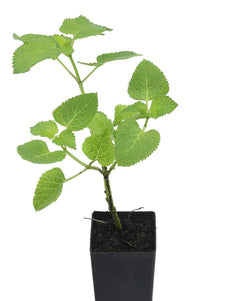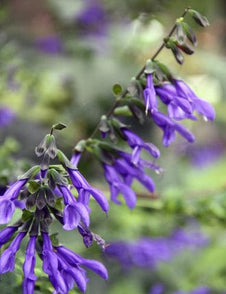





Salvia guaranitica 'Tequila'
Salvia guaranitica 'Tequila'

- Low stock - 5 items left
- Inventory on the way

Usually available: All year
Life cycle: Perennial
Height: 1.2 - 1.5m
Position: Sun / part shade
Soil preference: Well drained
This is how we pack and send your Herb Plants to all states except TAS & WA
You will receive
- 1 Salvia Gauranticia Herb Plant in a 50 X 75mm tube - General growing instructions
All of our Herb Plants are grown organically with certified organic potting mixes and fertilizers
Botanical Name: Salvia Guaranitica
Salvia guaranitica is shrubby salvia, with large blue flowers that grows to 1.3 meters tall and wide. The stems are both straight and branched, with a semi-wood texture and square shape. The stems also have a slightly flaky ‘bark’ that sits delicately on the stem and is easily brushed off. The leaves are long and wide at 4cm by 4cm, with an oval shape ending in a tapered point. They are dark green above and lighter on the underside. They are slightly toothed on the margins and quite wrinkled, with obvious veins. Underground the roots spread to form a wide base, which in turns helps the plant grow quite wide.
The large flowers are an electric blue colour and may be up to 5cm long each. They are the normal tubular salvia shape and the individual flowers are borne on showy inflorescences that extend upwards for 25 cm. The flowers have a hooded upper lip and a lower lip that dips slightly at the ends, curving back up to create the impression of serpent or dragons mouth on the side profile. The flowering season is long, with some reports that it lasts from late spring to early winter. In some climatic zones the season may be shortened to summer and autumn by the colder weather.
Blue Anise Sage is native to Brazil, Paraguay and Northern Argentina and it may sometimes be called Brazilian Sage. The plant needs room because it can get quite big, but this usually takes two or three years to reach its full size. There are several varieties ranging in height and colour: Argentina Skies, with pale blue flowers; Purple Splendour, with dark purple flowers and Black and Blue with deep blue flowers and a height of 1.8 meters.
There seems to be some confusion about the aroma of this salvia, with some reports saying they have an anise like fragrance and others saying they are not like anise at all. The ‘old form’ of this salvia had a reputation of spreading tubers throughout the garden, but new cultivars do not have this property.
Growing Conditions
Salvia guaranitica does well in part shade to full sun, but if there is too much shade it will become a little straggly, and even fall over, as the stems search for sun. It has a moderate water requirement and although it is a hardy plant, it is not drought tolerant. The preferred soil composition varies, but it is well adapted to chalky and limestone soils, so it may be a suitable choice of salvia for coastal gardens. Other soils it is well suited for include clay loams and sandy loam mixes.
In many regions this salvia is treated as a deciduous plant. In frost free areas the plant will remain as an evergreen shrub, but where frost is prevalent it will die down and return in spring. Where frost is mild the plant may survive if given extra protection, such as mulching the roots or covering it for warmth. As a general rule, Salvia guaranitica does better in a sheltered position, both due to frost tenderness and to provide some protection for the long stems against wind damage.
Propagation is by cuttings either new growth tips in spring or semi-wood tip cuttings in winter or autumn. Salvia guaranitica is not considered invasive, but does have a spreading root system which helps the plant above ground to spread and grow successfully to full size. Once a new plant is growing, the blooms appear in under twelve months and are reliable throughout the summer season. It is a very good plant to fill the back of a border near a fence, and does well with other cottage style perennials. As with all salvias, Blue Anise is a very good bird and butterfly attractant.
The salvia family has over 900 members with an extensive history as culinary, medicinal and ornamental plants. Ornamental salvias have become collectors’ items, as gardeners try to find a place in their garden for each and every one. There are salvias that will suit every type of soil and climate. More information on the Salvia genus and Common Sage (Salvia officinalis) may be found on our Common Sage page.
All information provided on this website is for informational purposes only. Please seek professional advice before commencing any treatment.





